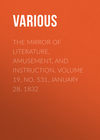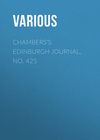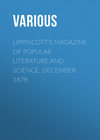Kitabı oku: «The Mirror of Literature, Amusement, and Instruction. Volume 19, No. 531, January 28, 1832», sayfa 2
"LACONICS," GUESSES AT TRUTH, &c
(For the Mirror.)
It is the interest of an indolent man to be honest: for it requires considerable trouble and finesse, to deceive others successfully.
Money was a wise contrivance to place fools somewhat on a level with men of sense.
It will be observed, that people have generally the identical faults and vices they accuse others of; we may instance cowardice.
Wherever a proposition is self-evident, it is but weakening its strength to bring forward arguments in its support.
It is a melancholy reflection that a glass of wine will do more towards raising the spirits, than the finest composition ever penned.
It is a great mistake in physiognomists to take outward signs as evidences of feeling: the seat of real sensation is within.
Wherever art has travelled out of her proper sphere to ape nature, she has proved herself but a miserable mimic, even in her most approved efforts.
We must not allow ourselves to dwell too seriously on life; for otherwise we shall be tempted to forego all our plans, to indulge in no future wishes, and, in short, to live on in torpid apathy.
Books are at last the best companions: they instruct us in silence without any display of superiority, and they attend the pace of each man's capacity, without reproaching him for his want of comprehension.
A disgust of life frequently proceeds from sheer vanity, or a wish to be supposed incapable of deriving gratification from the ordinary routine of happiness.
It sometimes happens that with men as well as animals, that evidences of spirit are only the effect of excited fear.
(To be continued.)
THE LAW INSTITUTION. 5
(At the time of our last publication we were not aware that any architectural details of the building in Chancery-lane had appeared. We now find that the Legal Observer contained such description in March last, "collected," says the editor, "with some pains and trouble." A correspondent dropped the Observer leaf into our letter-box in the course of last week; but, unfortunately, the communication did not reach us in time for insertion with our Engraving. Good news, we know, usually comes upon crutches, but we hope our thanks will reach this correspondent at a better pace.)
The style of architecture of the principal front in Chancery-lane is purely Grecian. The details and proportions appear to have been founded upon the best examples of the Ionic order in Athens and Asia Minor,6 but they are not servilely copied from any of them.
Mr. Vulliamy, the architect for the Institution, has thrown into this front the true spirit of the originals; and the effect which the harmonious proportions of the building produce on the spectator, when viewing it from Chancery-lane, must have been the result of much observation and experience in ancient and classic models.
This front, extending nearly sixty feet in width, is of Portland stone. It consists of four columns and two antae, of the Grecian Ionic order, supporting an entablature and pediment, and forming together one grand portico. To give the requisite elevation, the columns and antae are raised upon pedestals; these, as well as the basement story and podium of the inner wall of the portico, are of Aberdeen granite; the columns and the rest of the front are formed of large blocks of Portland stone. In the front wall, within the portico, there are two ranges of windows above the basement.
The front in Bell-yard extends nearly eighty feet, and will be finished with Roman cement, in imitation of stone. It will have a portico of two columns, and two antae of Portland stone, of the height of the ground story, which is very lofty, and the width of the entire compartment of the front. From the interior requiring to be divided into several rooms, this front must have many windows. The elevation is formed more upon the models of modern domestic architecture than of ancient public buildings, and resembles, in its general appearance, one of the palazzi in the Strada Balbi at Genoa, in the Corso at Rome, or in the Toledo at Naples. In its details, however, the extravagancies of the middle ages, and the often elegant frivolities of the cinque cento period, have been avoided, and the breadth and simplicity of Greek models have still been followed.
The ground plan of the building, by its general arrangement, divides itself into three parts, which may be distinguished under the heads of the Library, the Hall, and the Club Room. The first of these (that towards Chancery-lane) consists, on the ground floor, of a first and second vestibule, and staircase to the Library, the Secretary's Room, and Registry Office; and above these on the first floor, the Library, occupying the height of two stories.
The Library is a large and lofty room, fifty-five feet by thirty-one and a half, and twenty-three and a half high, divided by a screen of columns and pilasters of scagliola, into two unequal parts, the first forming a sort of ante-library to the other; both are surrounded by bookcases of oak, and a gallery runs round the whole, above which is another range of bookcases.
The principal light is obtained from a large lantern-light in the ceiling; but there is a range of windows (double sashed, and glazed with plate glass) towards Chancery-lane, which also admit light into the lower part.
All the floors in the building are made fire-proof, generally by being arched with brick; but that of the Library is rendered secure from fire by the ceilings of the vestibules underneath being formed of real stone, supported on iron girders and bearers, and divided into panels and compartments after the manner of the roofs of the peristyles of the ancient temples.
There are three entrances from Chancery-lane: that in the centre is exclusively for members, and leads to all parts of the building; that on the right for persons going to the Registry Office; and also for persons having to speak to members; that on the left leads down to the Office for the deposit of deeds, and to the strong rooms.
The second division consists of the Hall and its appurtenances. It is above thirty feet high, and fifty-seven feet and a half long; and on each side it has wings or recesses, behind insulated columns of scagliola, in imitation of Egyptian granite. Within these, and at the back of the columns, are galleries; the staircases to which are concealed in the angles. There are three fireplaces in the Hall; one in the centre, opposite the principal entrance, and one in the centre of each of the recesses. The Hall is lighted by a lantern-light forty feet long and twenty-four feet wide.
The third division is next Bell-yard: it is subdivided into two parts. In the first of these are three entrances from Bell-yard. That in the centre is exclusively for the members; that to the left leads to the staircase to the Secretary's apartments; and the other, to the right of the centre, is for strangers to enter who have business to transact in any of the rooms appropriated to public business. On the ground floor of this part of the third division is a large Committee Room, and an ante or waiting room adjoining, and the great staircase to the rooms above. On the first floor are the rooms for meetings on matters of business connected with the law; and above these are the Secretary's apartments.
The second part of the third division contains, on the ground floor, the Club Room, which occupies all the ground floor: it will be divided by columns and pilasters of scagliola, and decorated with a paneled ceiling and appropriate ornaments. Its dimensions are fifty feet by twenty-seven, and eighteen feet high. On the first floor are rooms of different dimensions for dinner parties; and over these, rooms for the resident officers. In the basement story of this part of the building are the Kitchen and other domestic offices for the use of the Club.
The office for the deposit of deeds is in the basement story, next to Chancery-lane.
In the remaining parts of the basement story of the building are fifty-two strong rooms, with iron doors, for the deposit of deeds, which are well ventilated and fire-proof; their average size is six feet and a half by seven feet and a half, but some are larger, and others rather less, than these dimensions. The whole are secured by one double iron door, with a very strong lock and master-key.
SPIRIT OF DISCOVERY
VAPOUR-BATHS
Among the remedies for cholera, or perhaps we should rather say attempted remedies, the vapour-bath is conspicuous over all the other means of cure, external and internal: stimulants, frictions, rubefacients, blisters, have that for their indirect object which the vapour-bath accomplishes directly, namely, to produce heat on the surface of the body, and thus restore that correspondence between the temperature of the interior and exterior parts, which in the disease is so strangely disturbed. There are two difficulties in the application of the vapour-bath, which are not easily overcome. When applied to the patient in the ordinary way, from the nature of the heat, the upper surface of the body is scorched, while the back is almost cold. Now in cholera, the application of heat to the back is of essential importance. In the whole of the machines for applying the bath, the patient is exposed to more or less tossing about; which, from the extreme prostration of strength in cholera patients, is always injurious; and as the patient must, when taken from the bath, be replaced on a comparatively cold bed, the sudden change will often do more ill than the bath will do good. To these must be added, in a disease which chiefly affects the poor, another item, forming an important drawback on the utility of the ordinary vapour-bath,—the application of it is attended with no inconsiderable expense. A machine which should obviate these objections, was a desideratum; and we think such a one has been invented by Mr. Burnet, of Golden Square. It is so simple as to be easily described without a diagram, and so well adapted to the end, and so easy and cheap in application, that we think we shall be rendering an acceptable service to our readers in describing it. The best way to effect this is to show the steps of its application.
We suppose the patient lying on his back in bed. The two sides of a framework, about 6-1/2 by 2-1/2 feet, are placed one on each side of him; five or six broad canvass straps, which are meant to support his body, are placed beneath him by a couple of attendants; two transverse pieces of wood are then introduced at the foot and head, to extend the framework; and the cross straps, by means of eyelet-holes, are attached to the sides, by a row of common brass pins. This is the work of about a minute. One attendant then raises the frame at the head, while the other introduces a couple of feet about nine inches long into the frame; and this done, the foot is raised in a similar way, and similarly supported; a board is then fitted to the foot, through a hole in the centre of which the chimney of the heating apparatus passes; the blankets are closely tucked round the patient and the frame; the lamp is applied, and the process of bathing commences. In this way, it will be seen that the patient is suspended in the heated air, which is moreover applied to the back in the first instance; there is no fatigue incurred; and when perspiration has been generated and carried on as long as is deemed expedient, he is let down again, without difficulty or danger, into his heated bed, and surrounded with the warm blankets employed in the bath itself. The room in which we saw the experiment performed, was at a temperature of 43° Fahrenheit; the clothes of the bed were of the same temperature: the lamp is conical, and has no tube; the wick is merely inserted in it; the charge is two ounces of spirits of wine. In ten minutes after the lamp had been applied, the thermometer at the foot of the frame on which the patient is made to recline, was 136°; at the head, 116°; on the blanket, which covered the bed, 96°. Were the vapour applied above the patient instead of under him, the difference between the heat at the breast and back would be at least 40°. The temperature once raised, may be kept up at a very small expense; so that the whole price of the bath, continued for half an hour or three quarters of an hour, will not exceed eightpence or ninepence. There is a very simple expedient, by which, when the temperature of the chamber formed by the frame of the bath is once raised sufficiently high, steam, either simple or medicated, may be introduced, and the lamp apparatus may be applied either at the foot, the head, or the side, as is most convenient. The grand recommendation, however, of the bath, is the applicability of the vapour to the entire surface of the body; the simplicity and ease of the application, both to the assistants and the patient; the exclusion of the possibility of cold; and its cheapness. In all these points of view, we look on it as a valuable invention.
Spectator.
Other contracts have been made with the above parties for the erection of the Club House, and Dining Rooms, &c., situate in Bell Yard, which is an addition subsequently made to the original building.










